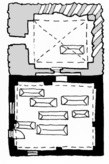Letter J
170. Jdēdtā / Khadītā | جديتا
Irbid Governorate
Maqām Shēkh Rabbā’
JADIS no. none
MEGA no. none
Coordinates: 32°24'23.0"N 35°42'31.0"E
32.406389, 35.708611
Letter J
Irbid Governorate
Maqām Shēkh Rabbā’
JADIS no. none
MEGA no. none
Coordinates: 32°24'23.0"N 35°42'31.0"E
32.406389, 35.708611
Plan: The old part of the maqām is rectangular in plan with an almost square burial chamber; entrance doors from the W and from the S; in the room corners projecting buttresses which carry semi-circular wall arches; in the quenches spheric pendantifs which merge into the flat cross vault. The recessed S entrance was framed an arch. A modern rectangular room corresponding in width to the old maqām has been recently added adjacent to the S wall, its entrance door is in the SW corner; two decentralized windows in the S and N wall.
Measurements: 16.8 m2 (old maqām only)
Exterior: ca. 5 m x 7.15 m.
Interior: (burial chamber) 4.20 x 4.0 m; concrete chamber added to the S 4.50 x 6.15 m.
Building Materials: At its N and E sides, the old part of the maqām has been carved in the natural limestone rock. The constructed parts are of local brownish limestone. The modern chamber has been constructed in concrete skeleton technique; the catenary dome is cast in cement.
Construction details: The corner pilasters and the arch in front of the S entrance consist of well-dressed cubic limestone, while the cross vault is composed of predominantly coarsely broken, unworked stones. The S exterior façade is widely covered by whitewashed plaster. Preservation: The old part is highly filled with rubble, earth and modern garbage. Only one tomb in the SE sector is visible in recent dump. The plaster at the walls remains only in several patches. The new room to the S contains various more recent tombs in E-W orientation. This part of the maqām is still visited by the villagers.
Inscription(s): none known.
Date(s): (Early?) Ottoman.
Traveler Reports: “ ... das Dorf dschdēdtā (vgl. Taf. 6 B) mit 60 Hütten, unter deren Bewohner 10 christliche Familien sind. Dabei stehen zwei Weli, im W (footnote:‘So ausdrücklich im Tagebuch [scil.: of G. Schumacher]; danach ist die Ansetzung des Weli auf der Karte nicht korrekt.’) das des schēch rabbā’ (569 m), im O das des schēch ‘abdu; bei dem ersteren findet sich eine Moschee (dschāmi’, 566 m) mit einer schön gerippten Kuppel, die freilich gänzlich zerfallen ist” (Steuernagel 1927).
Bibliography: Steuernagel 1927, A. 390; for historical trees in the wider area see Nueimat -Alkilani 2002, 57.





